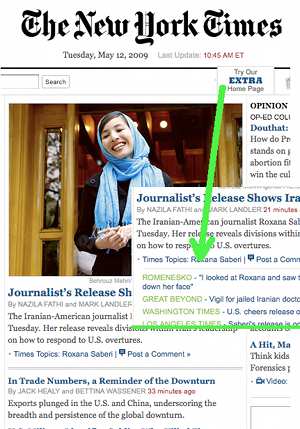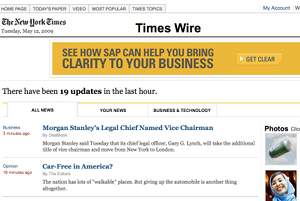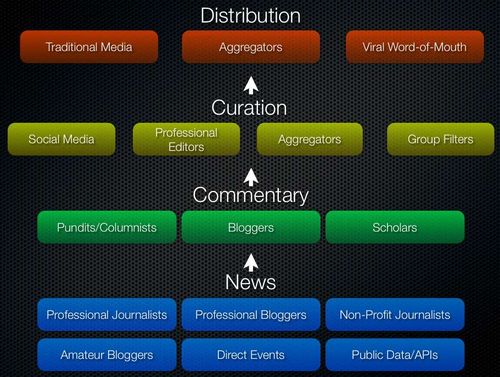The conversion to the new site is not perfect. For one thing, there was no way to preserve reader comments on the site, including some good conversations. I'm sorry about that.
If you encounter non-functioning links, look for their contents at the corresponding address on this new server. For example, the page formerly at "radio.weblogs.com/0106327/2007/01/14.html"
now should be at http://www.stepno.com/oldblog/2007/01/14.html
For my more recent blog entries, see http://stepno.com/blog
1:11:57 AM #
Don't let the title fool you... There's inspiration and a hint of optimism in Barbara Ehrenreich 2009 commencement address at the UC Berkeley Graduate School of Journalism: Welcome to a dying industry, journalism grads
Next, from Jane Singer, in an AEJMC discussion of the future of journalism & mass communication: one blue-sky scenario of how the not-too-distant future might look for our graduates. (Updated link & info: Since my original post, Jane's essay has won an AEJMC prize.)
Senate hears a dim forecast for newspapers' future by Andrew Miga, AP, via Google
Save the separation of press and state, by David Carr, NY Times
In Congress, no love lost for newspapers, Dana Milbank column in Washington Post
Laws That Could Save Journalism by Bruce W. Sanford and Bruce D. Brown in The Washington Post
"A Newspaper Bailout" by Adam Ross in the Post back in February, describing President Nicholas Sarkozy's plan to aid the French press.
They Pay for Cable, Music and Extra Bags. How about News? by Richard Perez-Pena and Tim Arango, NYTimes.
Sen. John Kerry's opening remarks as chairman of Senate Commerce Subcommittee on Communications, Technology and the Internet's hearing on "The Future of Journalism." Also from hearing, Arianna Huffington's testimony.
Video and transcripts from the "Free Press Summit" sponsored by the Knight Foundation.
Duke University's non-profit media conference, including Penelope Muse Abernathy's paper, "A Nonprofit Model for The New York Times?" -- which inspired this follow-up in the New Yorker. And more about the conference at The Nonprofit Road.
"Life after newspapers," by Michael Kinsley.
"The American Press on Suicide Watch," by Frank Rich.
"State of the News Media 2009" C-Span interview with Tom Rosentiel, on annual report of the Pew Project for Excellence in Journalism
"Do newspapers matter?" from the NYTimes economix blog, citing a Princeton study of the impact of the closing of The Cincinnati Post.
Meanwhile, see The newspaper crisis discussed at Princeton event, from NewJerseyNewsroom.com, a site founded when a bunch of journalists got together at a public library and decided to "create a news site -- unlike any other -- to address the growing journalism void."
"Clinging to a dead business model for dear life" and "The Biggest Threat to Newspapers is Newspapers" by Daily Kos
Scott Rosenberg, "How charging for articles could hobble the future of journalism."
"First, stop the lawyers," by Jeff Jarvis, Buzz Machine.
From the archives:
from "Newspapers and Thinking the Unthinkable" by Clay Shirky
"For the next few decades, journalism will be made up of overlapping special cases. Many of these models will rely on amateurs as researchers and writers. Many of these models will rely on sponsorship or grants or endowments instead of revenues. Many of these models will rely on excitable 14 year olds distributing the results. Many of these models will fail. No one experiment is going to replace what we are now losing with the demise of news on paper, but over time, the collection of new experiments that do work might give us the journalism we need."
from The Elite Newspaper of the Future by Philip Meyer, last fall in American Journalism Review.
The now-emeritus UNC professor suggests it's o.k. for newspapers to give up on "selling everything to everybody." Instead, he says they should focus on being trusted, responsible sources of evidence-based public affairs news and analysis, aimed at what the sociologists call "opinion leaders" -- what Phil calls "well-educated news junkies."
1:30:20 AM #
 In "Say It Ain't So, Izzy," the New Haven Independent's Paul Bass reviews a recent controversy over investigative journalist I. F. Stone's contacts with the Soviet Union... back when there was one. Apparently, Stone was someone the Soviet KGB talked to often enough in the 1930s to have a code name for him.
In "Say It Ain't So, Izzy," the New Haven Independent's Paul Bass reviews a recent controversy over investigative journalist I. F. Stone's contacts with the Soviet Union... back when there was one. Apparently, Stone was someone the Soviet KGB talked to often enough in the 1930s to have a code name for him. Bass's lead: "I.F. Stone, writer of truth to power, hero to generations of independent journalists... and Soviet agent?" The tale starts with a new Yale University Press book, Spies: The Rise and Fall of the KGB in America, particularly a handful of pages about Stone, whose career Paul sums up neatly:
Few survivors of the great 20th century political wars have remained as revered as Stone. He was a dogged reporter, a culler of public documents, a courageous defier of McCarthyism. He wrote passionate editorials for the once-liberal New York Post. He was a mainstay of the great newspaper experiment of the century, PM. When McCarthy's crowd drove many liberal writers out of business or underground, Stone refused to buckle. He published his own sheet, I.F. Stone's Weekly. It became a legend that continues to inspire independent journalists, and now bloggers.
Bloggers? In fact, Dan Froomkin at Harvard's Nieman Foundation has called Stone the best blogger ever, even though Stone died a decade before the first blogs were blogged. See Froomkin's review of a different book by Myra MacPherson. Also, here's an excerpt from that book: The importance of being Izzy and the death of dissent in journalism.
Marking the 2007 centennial of Stone's birth, Harvard's Nieman Foundation launched an I.F. Stone Medal for Journalistic Independence, presenting the first one last October. I don't see anything on the Harvard site about a 2009 award, or responding to the Yale Press book about what Stone did or didn't say to KGB spies 70 years ago. I hope this doesn't turn into some kind of Yale-Harvard game, but if it does get people reading, thinking and talking, that's OK too.
Until I've read more, I'll agree with Eric Alterman's Daily Beast characterization to Stone's activities in the 1930s:
"A man of avowed anti-Fascist sympathies, still-foolishly naïve about Stalin and the Soviet Union, agreed on a couple of occasions to help those whom he believed to be actually fighting fascism, while his own country, still mired in childish isolationism, looked away."
I.F. Stone led a long and productive life as a journalist, never disguised his left-leaning political sympathies, and inspired a generation of reporters to dig into public records, look for facts and contradictions, maintain their independence, and speak their minds. It would have been wonderful if he had also written an "apologia" for whatever dealings he had with the Soviets before World War II, or for not thoroughly denouncing the Soviet system before the mid-fifties, but I think his career is transparent enough. As the site for his (downloadable) collected writings says, "Izzy Stone was a reporter, a radical, an idealist, a scholar and, it is
clear, a writer whose insights have more than stood the test of time." For even more his work, the entire run of I.F. Stone's Weekly is now online at http://www.ifstone.org
4:21:41 PM #
 Linking "off site" was an early feature of blogs that commercial newspapers' sites were slow to adopt, for fear of letting the reader escape to the other distractions of the Web.
Linking "off site" was an early feature of blogs that commercial newspapers' sites were slow to adopt, for fear of letting the reader escape to the other distractions of the Web. We've come a long way... Now The New York Times "Extra" button on its home page gives you an expanded page view with extra links beneath the story summaries -- links to external content, such as Jim Romenesko's Media News blog, or related stories by other newspapers. (See the Washington Times and L.A. Times in the example at the left.)
And now there's TimesWire, a page similar to my old "Atex" in-basket on the newsroom editing system, c. 1980. Instead of "top stories" or story categories, you get the Times most recent stories in chronological order. This is sure to remind some people of http://news.google.com or realtime results on search.twitter like http://search.twitter.com/search?q=nytimes
It's even closer to Dave Winer's "River of News" approach, which builds a similar last-in page using the Times RSS feeds: http://scripting.com/rivers/nytimes/
Oops... I should have known Dave would get to this faster than I would: http://www.scripting.com/stories/2009/05/12/markThisDay.html
 I can't believe it's been almost three years since I wrote this about news rivers... Unfortunately the first part of my 2006 post refers to a site that no longer exists, but this part is still relevant:
I can't believe it's been almost three years since I wrote this about news rivers... Unfortunately the first part of my 2006 post refers to a site that no longer exists, but this part is still relevant:News Nerd Nostalgia: Ah, ATEX. Back when Jimmy Carter was president, anyone with a big computer downstairs and tens of thousands of dollars in wire service subscriptions could read a daily "river of news" on our computer screens. (The people I'm talking about were editors at daily newspapers. I was compiling a daily page two "People" column using wire news, so I got one of the first wave of terminals at The Hartford Courant.)
We could scroll down through all the days stories in reverse-chronological order, even split the screen to compare the AP and UPI wire stories about the same event, then move paragraphs back and forth to create a "combined wires" story. You could choose whether to just browse the headlines, or expand them all to whatever number of lines of the story would give you enough information. It still felt very "Buck Rogers" as late as 1979! When I went back to grad school that year, I was disappointed to find that the university's computer terminals couldn't do anything like ATEX. Most of them didn't even do upper-and-lower-case letters. Times & technology do change.
2:33:53 PM #

Unrelated to the "Pearls Before Swine" comic strip above -- also not to be confused with the wonderful Pearls Before Breakfast, which I use as an example of break-the-rules storytelling in newswriting class. This one is a horror story about the meeting of two pandemics, a fable of uncertain authorship published by the LA Observed Web site last week.
Lessons from St. Pete...
And, finally, the good news... The executive editor of the St. Petersburg Times extracts some lessons from the day his paper won two Pulitzer Prizes...
Editor Neil Brown's short list:
- Newspapers can innovate.
- Internet versus print? It's a false choice.
- Despite cutting costs, we still do meaningful work.
- Powerful stories move us and unite us.
The Web also played a big part in those Pulitzers -- one for the paper's PolitiFact.com election coverage and online database, the other for a simultaneously heart-breaking and heart-warming story about a horribly neglected girl and the adoptive parents who changed her life. That story, a long-form journalistic narrative titled "The Girl in the Window," is probably most read story the Times has produced, Brown said, estimating it has had well over a million readers in print and online.
(I posted more links about the Pulitzer winners last month.)
2:30:09 PM #
From the TED intro: "Jacek Utko is an extraordinary Polish newspaper designer whose redesigns for papers in Eastern Europe not only win awards, but increase circulation by up to 100%. Can good design save the newspaper? It just might."
For more examples, try his home page, http://www.utko.com
 Newspaper-use habits -- from scanning the headlines over breakfast to the daily crossword and the Sunday comics -- only apply to people who *have* those habits.
Newspaper-use habits -- from scanning the headlines over breakfast to the daily crossword and the Sunday comics -- only apply to people who *have* those habits. People under 30 don't, and their parents probably didn't. (I was knee-deep in newspapers before I was two, as shown on the right.) A note at Nielsen-online.com tries to compare newspapers to that other old medium challenged by digital distribution -- the CD. But CDs -- or vinyl LPs -- have the "build a collection" theme, which newspapers don't -- except for the "Dewey Beats Truman," "Man on Moon," "Obama Wins!" type of historical front page.
Could newspaper front pages become not only informative, but collectible works of art, like LP jackets were in the 1960s? Seems far-fetched, but maybe Mr. Utko is onto something. A few days after I posted the original version of this item, the Louisville Courier-Journal printed a front page that I might even order in hard-copy for $20, even though it's on the Web: An artist's hand-drawn facsimile of a typeset front page. Take that, Mr. Gutenberg and Mr. Mergenthaler!
Could collectible front pages pay for investigative reporting, watchdog journalism and the whole "Fourth Estate" role of the press? Maybe not, but they might get new readers to open the paper. The next step would be to keep putting something equally valuable inside. For examples, bookmark Extra, Extra!
3:30:13 PM #

Seeing a new media ecology
My headline takes some liberties with Stephen Berlin Johnson's ecological metaphor for the current transition in the reporting and delivery of news, but I recommend his essay, one of several good ones this week on saving the news or finding a sustainable model for civic or public affairs journalism. Johnson's discussion leads to his information flowchart at the right.
For more about the trend in newspapers going online-mostly, online-only or out of business, see these:
Johnson's thoughts came out of the much-blogged-about South by Southwest (sxsw) conference, while a panel discussion on the future of The San Francisco Chronicle -- and local news reporting -- inspired Salon co-founder Scott Rosenberg and blogger Dave Winer to write equally thoughtful essays, each finding some room for optimism -- if not about newspapers, about the future of news itself.
(Also see Rosenberg on journalism schools, and Clay Shirky's piece I mentioned a few days ago.)
10:24:05 AM #
Copyright 2009 Bob Stepno
Theme Design by Bryan Bell